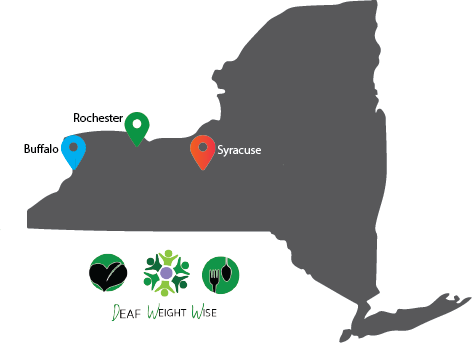Rochester Prevention Research Center: National Center for Deaf Health Research
Population of Focus: Deaf American Sign Language (ASL) users and people with hearing loss
Topic Areas: promotion of health education, resources, and disease prevention in Deaf communities, communities with hearing loss, and rural communities
Introduction, Mission, and Vision
The Rochester Prevention Research Center: National Center for Deaf Health Research (RPRC: NCDHR) is one of 26 Prevention Research Centers (PRCs) supported by the Centers for Disease Control and Prevention (CDC) for the 2019–2024 funding cycle. Each PRC is funded to establish and maintain their center and to conduct a core research project. PRCs may receive supplemental funding to conduct additional research projects and activities.
RPRC: NCDHR works with populations of Deaf American Sign Language (ASL) users and people with hearing loss. These two distinct populations have often been overlooked, excluded, and underserved by health care, health research, and public health programs. Because most health research programs that include Deaf people and people with hearing loss have historically focused on hearing acuity, information about basic health indicators for these populations is lacking.
RPRC: NCDHR is the only research center in the world using community-based participatory research methods to promote health and prevent disease among Deaf ASL users and people with hearing loss. Its goals are to:
- Eliminate health disparities in populations of Deaf ASL users and people with hearing loss.
- Build lasting collaborative relationships with its partners and partner communities.
- Implement effective, evidence-based health promotion interventions in populations of Deaf ASL users and people with hearing loss.
- Establish the RPRC: NCDHR as a leading health research organization.
RPRC: NCDHR seeks to accomplish these goals by providing resources, education, tools, and programs to its priority populations. Its vision is for these communities to establish long-term health solutions that result in long-term health benefits. These benefits can include receiving, adapting, and applying health-promoting behaviors to prepare for new public health threats.
Core Research
Each PRC uses a community-engaged approach to conduct one primary applied public health prevention research project called a core research project. Project activities include design, development, implementation, evaluation, and dissemination. PRCs use at least 50% of their CDC funding to conduct the project in partnership with communities.
Deaf Weight Wise (DWW): Implementation Research

RPRC DWW map of community partners.
RPRC: NCDHR’s core research project for the 2019–2024 funding cycle is the study and implementation of DWW, a healthy lifestyle tool developed by Deaf people for Deaf ASL users. DWW was adapted from an evidence-based healthy lifestyle program at the University of North Carolina’s Prevention Research Center and tested in two clinical trials with Deaf participants at RPRC: NCDHR.
The clinical trials have shown that DWW is effective with Deaf participants aged 21 to 70. Researchers are currently working with community partners in Rochester, Buffalo, and Syracuse, New York, to prepare them to use DWW to broaden its reach.
“I appreciate all the efforts RPRC: NCDHR has put into identifying our specific needs and then working with us to help many Deaf people, including myself, develop better eating habits and learn weight monitoring techniques,” said Karen Beiter, co-chair of the DWW Community Committee. “I also appreciate that this was done using American Sign Language so we can all develop trust with each other and be fully involved in the collaboration [and] experience sharing, instead of joining other groups with interpreters where we would be more like interested bystanders.”
The DWW project was included in the Association of the American Medical Colleges’ Health Equity Research Snapshot, which highlights videos of innovative community-partnered research projects at PRCs.
Additional Research
PRCs may receive supplemental funding to work on additional research projects each funding cycle. These Special Interest Projects (SIPs) focus on a variety of health topics or gaps in scientific evidence. PRCs can also conduct additional research as part of SIP Thematic Research Networks, which are groups of PRCs working together on related health topics.
RPRC: NCDHR has worked on additional research that address social determinants of health among Deaf ASL users, including projects that focus on STI/HIV education and awareness, COVID-19 information access, and strategies to improve and maintain gainful employment for people with hearing loss. It also provides an education and training activity called Deaf Strong Hospital (DSH) to first-year medical students at the University of Rochester’s School of Medicine and Dentistry. DSH uses an entertaining role-reversal exercise in which students become “patients” seeking health care from “doctors” who are members of local Deaf communities.
Improving and Evaluating Measures to Identify Tics and Tic Disorders Including Tourette Syndrome in Children in Epidemiologic Studies and Clinical Settings
This SIP will test tic screening and diagnostic instruments in primary pediatric care settings to increase identification of tics and co-occurring conditions to improve access to care and outcomes.
PRC Vaccine Confidence Network (PRC VCN)
In April 2021, CDC funded a 12-month award to all 26 PRCs to form the PRC VCN in support of the agency’s Vaccinate with Confidence strategy for COVID-19. As part of this network, RPRC: NCDHR is examining vaccine hesitancy to find ways to promote vaccine confidence, increase vaccine uptake, and reduce disparities in rural communities. The goal is to reduce the incidence of COVID-19 in the United States.
RPRC: NCDHR’s strategy includes recruiting trusted messengers who use tailored social media content, text campaigns, and print materials to reach people in their own social networks. These trusted messengers include rural residents who have already received the vaccine, health care providers, and community opinion leaders.

Location: Rochester, New York
Principal Investigator: Steven Barnett, MD
Email ncdhr@urmc.rochester.edu